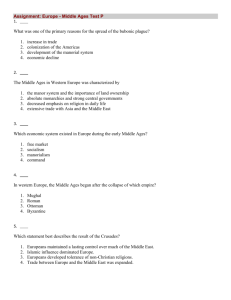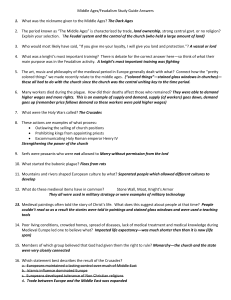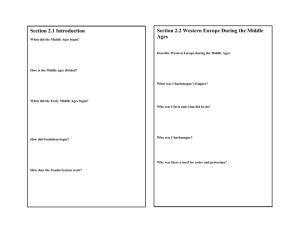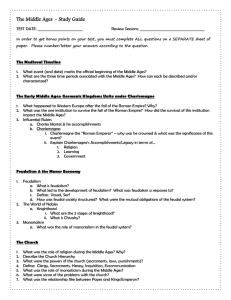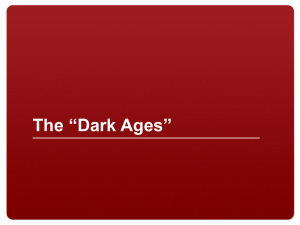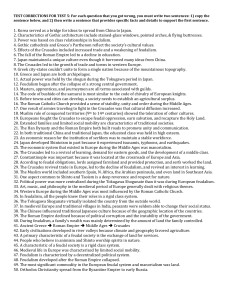stained feudal
advertisement
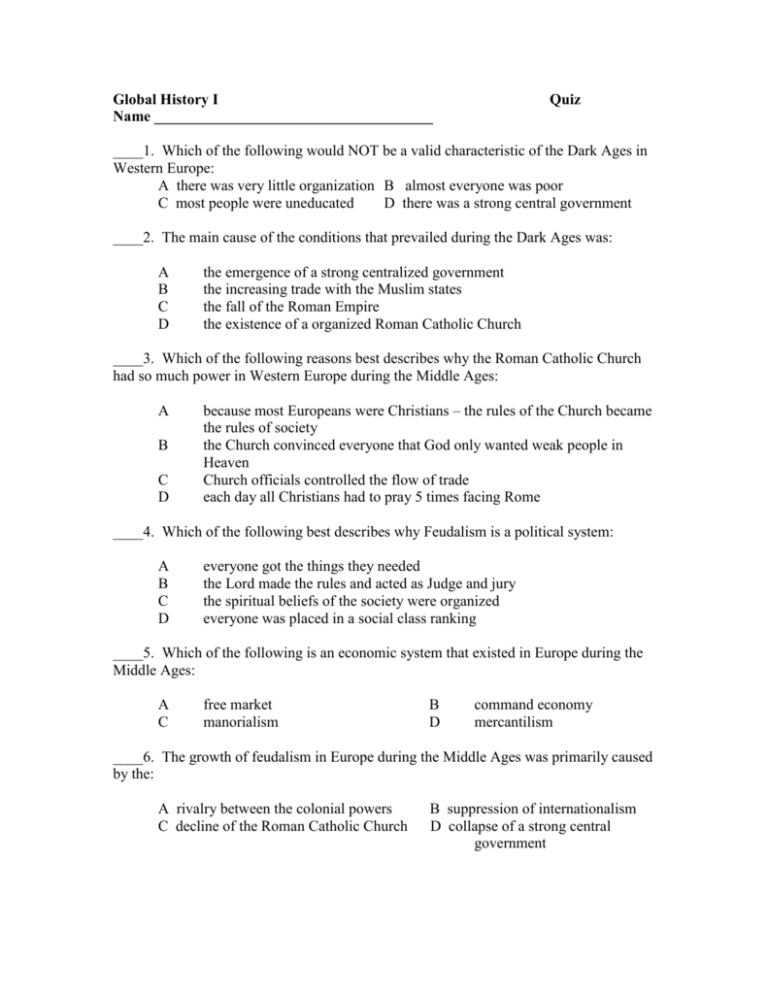
Global History I Name _____________________________________ Quiz ____1. Which of the following would NOT be a valid characteristic of the Dark Ages in Western Europe: A there was very little organization B almost everyone was poor C most people were uneducated D there was a strong central government ____2. The main cause of the conditions that prevailed during the Dark Ages was: A B C D the emergence of a strong centralized government the increasing trade with the Muslim states the fall of the Roman Empire the existence of a organized Roman Catholic Church ____3. Which of the following reasons best describes why the Roman Catholic Church had so much power in Western Europe during the Middle Ages: A B C D because most Europeans were Christians – the rules of the Church became the rules of society the Church convinced everyone that God only wanted weak people in Heaven Church officials controlled the flow of trade each day all Christians had to pray 5 times facing Rome ____4. Which of the following best describes why Feudalism is a political system: A B C D everyone got the things they needed the Lord made the rules and acted as Judge and jury the spiritual beliefs of the society were organized everyone was placed in a social class ranking ____5. Which of the following is an economic system that existed in Europe during the Middle Ages: A C free market manorialism B D command economy mercantilism ____6. The growth of feudalism in Europe during the Middle Ages was primarily caused by the: A rivalry between the colonial powers C decline of the Roman Catholic Church B suppression of internationalism D collapse of a strong central government ____7. Which was a characteristic of feudalism: A B C D land was exchanged for military service and obligations government was run by a bureaucracy of civil servants power rested in the hands of a strong central government unified national court systems were developed ____8. As the Middle Ages ended, the rise in trading activity and market places in Western Europe can be attributed to which of the following: A B C D The emergence of feudalism cultural diffusion brought about by the Crusades economic policies of the Roman Empire strength of Christianity in Europe ____9 One result of the Crusades on Western Europe was: A B C D the conversion of Muslims to Christianity permanent occupation of the Holy Lands by the Christians a long-term decrease in European trading activity a return of ancient Greek and Roman cultural ideas to Europe ____10. Which of the following events did NOT help bring about the end of feudalism in Europe: A C The Crusades The fall of the Roman Empire B D The Hundred Years War The Black Death ____11. Which of the following was a main effect of the Hundred Years War: A B C D political unity was achieved in England and France the Reformation began in the German states trade increased between Italy and the rest of Europe new weapons helped bring about the end of Feudalism ____12. Which style of architecture is characterized by stained glass windows, tall spires, flying buttresses, and pointed arches? A Corinthian C Gothic B neoclassical D Ionic ___13. Which is a characteristic of a feudal society? A rapid social change B high literacy rate C industrial based economy D rigid class structure ___14. The Middle Ages in Western Europe were characterized by A B C D the manor system and the importance of land ownership absolute monarchies and strong central government decreased emphasis on religion in daily life extensive trade with Asia and the Middle East ___15. Which is the most valid generalization about the Crusades? A the Crusades strengthened the power of the serfs in Europe B the Crusades increased trade between Europe and Asia C the Crusades brought European influence to Africa D the Crusades promoted the idea of religious tolerance ___16. Which statement best describes the role of the Roman Catholic Church in Europe during the Middle Ages? A the Church encouraged individuals to question authority B Church leaders were involved solely in spiritual activities C The Church gained influence as the world became more secular D The Church provided a sense of stability, unity, and order ___17. In Europe during the Middle Ages increases in trade and commerce resulted in A lower living standards for industrial workers B decreased economic rivalry between kings C increased political power for the clergy D development of towns and cities ___18. “All things were under its domain…its power was such that no one could hope to escape its scrutiny.” A the guild B knighthood C the Church D the nation-state Base your answers to 6 and 7 on the illustration below and your knowledge of social studies. ___19. Which political system is associated with the social stratification system shown in the illustration A Fascism B Feudalism C Communism D Socialism ___20. In both Europe and Japan, the major reason for the development of the political system shown in the illustration was to A eliminate the need for a legal system B increase trade and manufacturing in the region C consolidate the political power of religious leaders D provide order during a period of weak central governments ___21) Feudalism in Western Europe was similar to feudalism in Japan in that A power was based on class relationships B the national government controlled the nobility C social mobility was easily achieved D most of the people lived in cities ___22) In medieval Japan and medieval Europe, the feudal system was dominated by A middle-class merchants B peasant farms C radical revolutionaries D warrior aristocrats ___23) The warlords of China, the samurai of Japan, and the knights of Western Europe were similar because they all were influential during periods of A weak central government B increasing nationalism C religious and political reform D invasions by foreigners ___24. In Europe during the Middle Ages, the force that provided unification and stability was the A central government in Rome B military alliance between France and Germany C federation of the craft guilds D Roman Catholic Church ___25. In western Europe during the Middle Ages education declined as a direct result of the A rediscovery of classical Greek civilization B loss of the power of the Christian Church C fall of the Roman Empire D rise of absolute monarchs ___26. One way the Church disciplined its critics was by A Demesne B Excommunication C Simony D public hangings ___27. Serfs were A bound to their master B the property of the state C slaves D bound to the land ___28. The three-field system used on the medieval manor was designed to A provide an even division of lands among the lord, the villagers, and the Church B prevent the soil from wearing out C provide for the woodland, waste, and meadow to be used in common D encourage peasants to experiments with new agricultural methods ___29. Many classical (Greek and Roman) ideas became less important during the early Middle Ages because the people of that time A wanted to choose their own values B found new customs more interesting C adopted the culture of the Middle East D were forced to focus their attention on more basic survival skills ___30. The pope’s power to deny a person the sacraments is called A benefit of clergy B investiture C canon law D excommunication ___31. Which of the following factors helped make the Church powerful during the Middle Ages? A control of the sacraments B threat of excommunication C ownership of land D collection of the tithe ___32 Which best describes the position of the Roman Catholic Church in western Europe in the centuries following the fall of the Roman Empire? A the church’s influence declined as it lost most of its membership B the importance of church increased as it took over some duties normally held by central governments C the church encouraged the growth of different beliefs D church leaders withdrew from public life and confined their activities to monastaries ___33. The political system in Western Europe between the fall of Rome and the rise of national states (1500) was A the city-state B the republic C feudalism D democracy ___34. The courts of the INQUISITION were established to A combat heresy B stamp out corruption C convert the Germanic barbarians D punish traitors to the king ___35. A vassal’s chief duty to his Lord was A military service B paying ransom C giving advice in legal matters D hosting a feast ___36 Under the manorial system, a peasant owed his lord A a tithe B about three day’s work each week C free use of the village mill D any children they had ___37. In European feudal society an individual’s social status was generally determined by A birth B education and training C individual abilities D marriage ___38. What was the center of the early medieval economy? A agriculture B industry C trade and commerce D warfare ___39. Which is the best description of the economic system of the Early Middle Ages? A it was a traditional system which was self-sufficient B a market economy, it depended on trade and commerce C as a command system, the peasants made decisions D communal ownership led to decision making by the noble and serf’s together ___40. During the Middle Ages, the lending of money for interest was prohibited by the church and was called A homage B usury C donation D tithe ___41. The “arms” that helped support the new thinner walls of Gothic Cathedrals were A Romanesques B Buttresses C Alchemists D Gargoyles ___42. During the late Middle Ages 2/3 of the population was wiped out due to A rats B fleas C plague D famine ___43. The purpose of stained glass windows and statutes in medieval cathedrals was A purely for decoration B to educate the illiterate about church beliefs C to employ craftsmen and stimulate the economy D considered a waste of money by most people of the time ___44.During the Middle Ages the religion of western Europe was Roman Catholic, the religion of the Byzantine Empire was A Eastern Orthodox B Protestant C Jewish D Islamic ___45. All of the following were effects of the Crusades EXCEPT A cultural diffusion into Europe of a more advanced Muslim culture B new products which led to a demand for more goods from the East C rediscovery of lost Greek and Roman ruins by Western Europe D decreased contact with Islam and Byzantium


